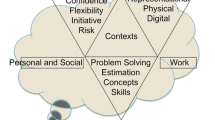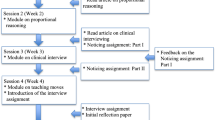Abstract
This study presents an analysis of whether geometry teachers create opportunities for student discussion when engaging students in proving as revealed through the use of a multimedia survey instrument. We presented 42 secondary mathematics teachers with 8 multimedia narratives set in the situation of doing proofs in high school geometry and asked them to choose what they would do next, presenting options that included a normative instructional action which closed off discussion and less typical actions that encouraged student discussion. Our analysis provides insight into the professional obligations that teachers use to justify their departure from the norm in order to encourage student talk as well as the background variables that are associated with such decisions. We found that while secondary mathematics teachers frequently chose to promote discussion in their classrooms, the rationale that they chose for this decision and the reasons they might choose not to immediately encourage discussion differed according to the amount of experience they had teaching geometry. We use these differences to illustrate how the professional obligations can be used to better understand how teacher decisions are rationalized at the level of the instructional situation.

Similar content being viewed by others
Notes
Responses are tracked according to participant ID and item number.
References
Boerst, T., Sleep, L., Ball, D. L. & Bass, H. (2011). Preparing teachers to lead mathematics discussions. Teachers College Record, 113(12), 2844–2877.
Boyd, D., Grossman, P., Lankford, H., Loeb, S. & Wyckoff, J. (2006). How changes in entry requirements alter the teacher workforce and affect student achievement. Education, 1(2), 176–216.
Chan, D. & Schmitt, N. (1997). Video-based versus paper-and-pencil method of assessment in situational judgment tests: Subgroup differences in test performance and face validity perceptions. Journal of Applied Psychology, 82(1), 143–159.
Chazan, D. & Lueke, M. (2009). Exploring relationships between disciplinary knowledge and school mathematics: Implications for understanding the place of reasoning and proof in school mathematics. In D. Stylianou, M. Blanton & E. Knuth (Eds.), Teaching and learning of proof across the grades: A k-16 perspective (pp. 21–39). New York, NY: Routledge.
Cirillo, M., & Herbst, P. G. (2012). Moving toward More Authentic Proof Practices in Geometry. Mathematics Educator, 21(2), 11–33.
Cobb, P., Wood, T., Yackel, E. & McNeal, B. (1992). Characteristics of classroom mathematics traditions: An interactional analysis. American Educational Research Journal, 29(3), 573–604.
Ge, X. & Land, S. M. (2003). Scaffolding students’ problem-solving processes in an ill-structured task using question prompts and peer interactions. Educational Technology Research and Development, 51(1), 21–38.
Herbst, P. G. (2006). Teaching geometry with problems: Negotiating instructional situations and mathematical tasks. Journal for Research in Mathematics Education, 37(4), 313–347.
Herbst, P., Aaron, W., Dimmel, J., & Erickson, A. (2013a). Expanding students’ involvement in proof problems: Are geometry teachers willing to depart from the norm? Paper presented at the annual meeting of the American Educational Research Association, San Francisco, CA. Retrieved from http://hdl.handle.net/2027.42/97425.
Herbst, P., Aaron, W., & Erickson, A. (2013b). How preservice teachers respond to representations of practice: A comparison of animations and video. Paper presented at the 2013 meeting of the American Educational Research Association, San Francisco. Deep Blue at the University of Michigan. http://hdl.handle.net/2027.42/97424.
Herbst, P., Kosko, K., & Dimmel, J. (2013c). How are geometric proof problems presented? Conceptualizing and measuring teachers’ recognition of the diagrammatic register. In Proceedings of the 35 th Annual Meeting of the North American Chapter of the International Group for the Psychology of Mathematics Education (pp. 179–186). Chicago, IL: University of Illinois at Chicago.
Herbst, P., & Brach, C. (2006). Proving and doing proofs in high school geometry classes: What is it that is going on for students? Cognition and Instruction, 24(1), 73–122.
Herbst, P., & Chazan, D. (2012). On the instructional triangle and sources of justification for actions in mathematics teaching. ZDM, 44(5), 601–612.
Herbst, P., Chazan, D., Kosko, K. W., Dimmel, J., & Erickson, A. (2016). Using multimedia questionnaires to study influences on the decisions mathematics teachers make in instructional situations. ZDM, 48(1-2), 167–183.
Herbst, P., Chen, C., Weiss, M., González, G., Nachlieli, T., Hamlin, M., & Brach, C. (2009). “Doing proofs” in geometry classrooms. In D. Stylianou et al. (Eds.), Teaching and learning proof across the grades (pp. 250–268). New York, NY: Routledge.
Herbst, P., & Kosko, K. W. (2014). Using representations of practice to elicit mathematics teachers’ tacit knowledge of practice: a comparison of responses to animations and videos. Journal of Mathematics Teacher Education, 17(6), 515–537.
Knuth, E. J. (2002). Secondary School Mathematics Teachers’ Conceptions of Proof. Journal for Research in Mathematics Education, 33(5), 379–405.
Kosko, K. W., & Herbst, P. (2012). Evaluating teachers’ decisions in posing a proof problem. In L. R. Van Zoest, J. J. Lo, & J. L. Kratky (Eds.), Proceedings of the 34th annual meeting of the North American Chapter of the International Group for the Psychology of Mathematics Education (pp. 813–820). Kalamazoo, MI: Western Michigan University.
Lievens, F., Peeters, H. & Schollaert, E. (2007). Situational judgement tests: A review of recent research. Personnel Review, 37(4), 426–441.
Much, N. C., & Shweder, R. A. (1978). Speaking of rules: The analysis of culture in breach. New Directions for Child and Adolescent Development, 2, 19–39.
National Governors Association. (2010). The Common Core State Standards. Retrieved from http://www.corestandards.org/the-standards/mathematics
O’Connor, M. C. (2001). “Can any fraction be turned into a decimal?” A case study of a mathematical group discussion. Educational Studies in Mathematics, 46(1-3), 143–185.
Shavelson, R. J. & Stern, P. (1981). Research on teachers’ pedagogical thoughts, judgments, decisions, and behavior. Review of Educational Research, 51(4), 455–498.
Stein, M. K., Engle, R. A., Smith, M. S., & Hughes, E. K. (2008). Orchestrating productive mathematical discussions: Five practices for helping teachers move beyond show and tell. Mathematical Thinking and Learning, 10(4), 313–340.
Stein, M. K. & Smith, M. (2011). 5 practices for orchestrating productive mathematics discussions. Reston, VA: National Council of Teachers of Mathematics.
Stigler, J. W., & Hiebert, J. (1999). The teaching gap: Best ideas from the world's teachers for improving education in the classroom. New York, NY: Free Press.
Weekley, J. A., & Ployhart, R. E. (Eds.). (2013). Situational judgment tests: Theory, measurement, and application. Mahwah, NJ: Lawrence Erlbaum.
Whetzel, D. L. & McDaniel, M. A. (2009). Situational judgment tests: An overview of current research. Human Resource Management Review, 19(3), 188–202.
Yackel, E., Cobb, P. & Wood, T. (1991). Small-group interactions as a source of learning opportunities in second-grade mathematics. Journal for research in mathematics education, 22(5), 390–408.
Acknowledgments
The work presented in this paper has been done with support of NSF grant DRL-0918425 to P. Herbst. All opinions are those of the authors and do notnecessarily represent the views of the Foundation.
Author information
Authors and Affiliations
Corresponding author
Rights and permissions
About this article
Cite this article
Erickson, A., Herbst, P. Will Teachers Create Opportunities for Discussion when Teaching Proof in a Geometry Classroom?. Int J of Sci and Math Educ 16, 167–181 (2018). https://doi.org/10.1007/s10763-016-9764-4
Received:
Accepted:
Published:
Issue Date:
DOI: https://doi.org/10.1007/s10763-016-9764-4




